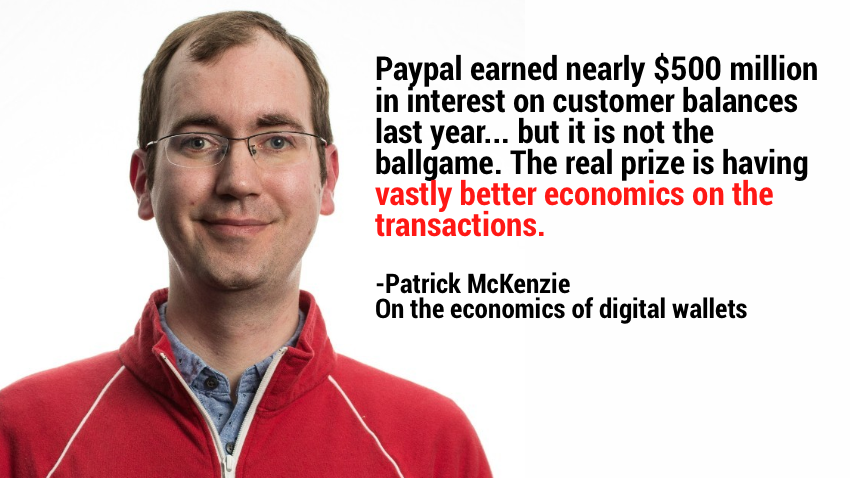Every week, we look at a couple of stories at the intersection of banking, data, and technology that either were missed in the headlines or that present a different view that’s worth looking at.
This week, looking at the economics of digital wallets and the mechanism for justice in the municipal bond markets.
1. The business of wallets
Patrick McKenzie continues his series of breakdowns on the economics of payments with this look at how digital wallets, like CashApp, Venmo, and Apply Pay make money.
The first option is going to be making a debit card backed by the wallet balance, with the card issued by a banking partner that (in the U.S.) is certain to be a Durbin-exempt institution (read community bank or credit union). This is an obvious no-brainer, your product team will tell you. Currently, when your users want to get money out of the ecosystem to e.g. their bank accounts, you pay money. Why not earn money instead? Get a co-branded debit card offering and your banking partner will provide you a revenue share on every transaction out. (How much is something of a trade secret, but if you were thinking somewhere in the 100 bps ballpark, you’d be close enough to interview as a PM at a fintech company.)
Paypal and their card issuing partner financial institution are mutually happy with the performance of the portfolio.
Additionally, Patrick breaks down the role scale and negotiating power employed by the likes of WalMart and Apple…
“Apple might have said something rhyming with “If you don’t do this, we will find a two-sided payment network willing to do business with us. If we can’t find them, we will build it, and people will use it, because they like us more than they like you.”
Apple has been publicly reported to make 15 bps on each transaction which goes over Apple Pay.
2. Munis and community equity
Heather Gillers of The Wall Street Journal writes this story on Stamford professor Destin Jenkins and his work to uncover and remediate inequalities in how communities are funded.
People tend to think of munis—if they think of them at all—as the boring part of their investment portfolio, or the funding for the new school being built down the street. The bankers and bureaucrats involved in the day-to-day operations of the $4 trillion market for state and local debt tend to be more focused on yield curves than historical transgressions.
But the market has also, many argue, helped some Americans a lot more than others. Studies show that Black communities often pay more to borrow in the muni market.
The work of Destin and others led to Congress’s 2021 hearing on race and muni markets.
Lawmakers were presented with an academic study about historically Black colleges and universities. Organizations like colleges are eligible to borrow alongside states and cities in the muni market.
HBCUs paid disproportionately higher underwriting fees, especially the HBCUs in Alabama, Mississippi and Louisiana, according to the study. The higher fees suggest that trading desks found it more difficult to find buyers.
Another study looked at about half of all bonds outstanding as of April 2022. It found that places with more Black residents pay a combined total of roughly $900 million a year in extra interest unexplained by other factors—a phenomenon sometimes called “the Black tax.”
Beyond market dynamics and the role the tax code plays, Destin has looked at ways rating agencies
He suggested that along with the risk of natural disasters, pandemics and cybercrimes, Moody’s should evaluate “democracy risk.” He argued that investors might want to steer clear of places where, for example, restrictions on voting rights could lead courts to eventually invalidate bond deals approved by voters.
Elsewhere, he and others have suggested that police misconduct is bad for bondholders. Cities spend millions of dollars a year on legal payouts in cases involving alleged brutality, wrongful detention or other misconduct.
More in the article and his book the Bonds of Inequality.
That’s the week. Moving is always a pain, but how to deal with back-to-back NBA and NHL playoff games in the same arena? Just 2 hours of work from 60 of your closest friends.
Click below to let us know how we did:

